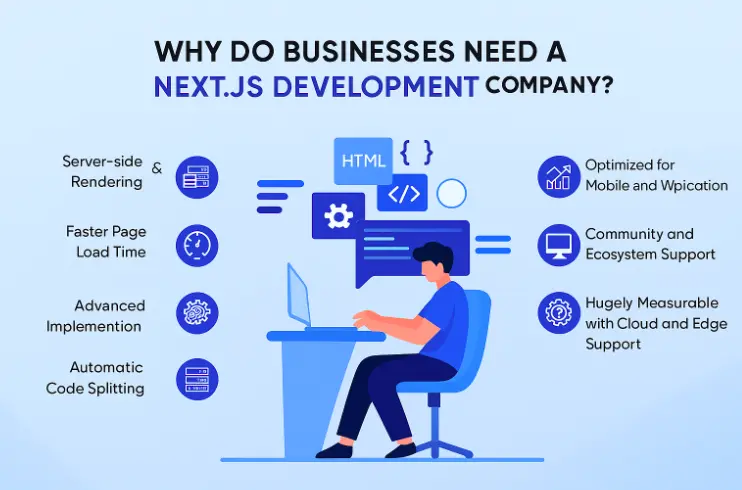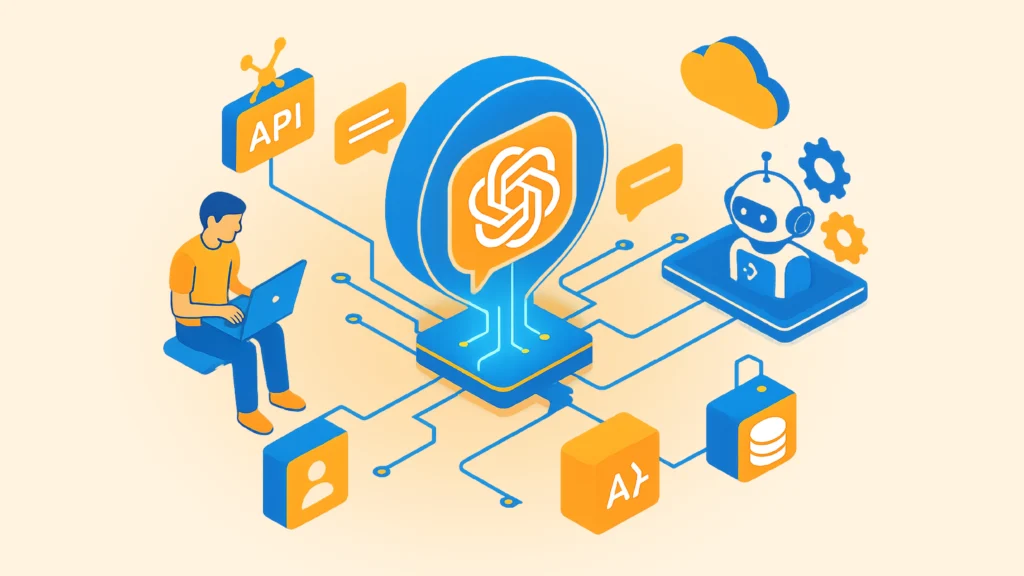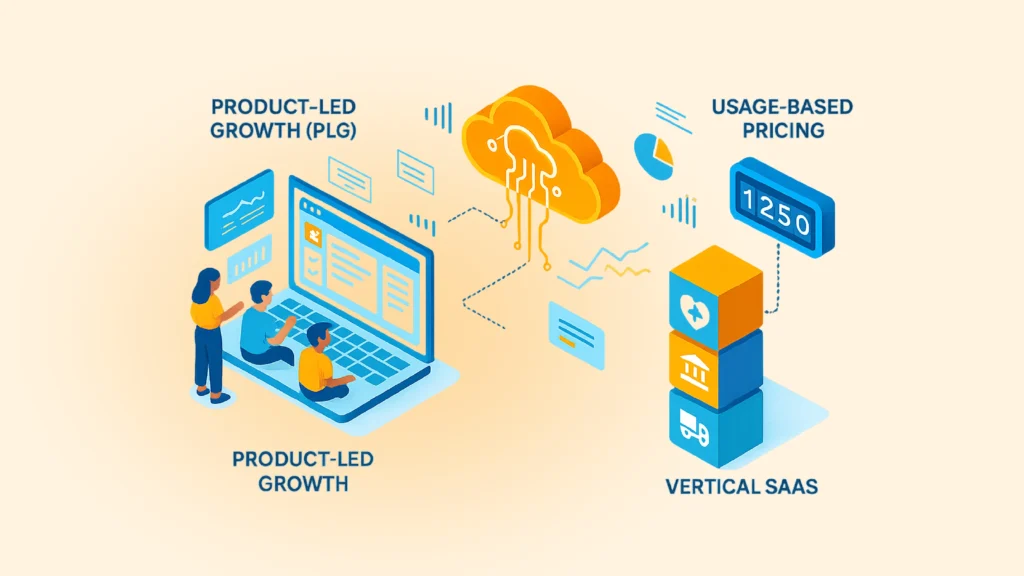Why Businesses Should Choose Next.js for High-Performance Web Apps
Why Businesses Should Choose Next.js for High-Performance Web Apps
- September 29, 2025
- 7 Mins Read
Quick Summary
Businesses across the globe are looking for a Next.js development company, helping them create measurable and aesthetic web applications that offer exceptional performance, scalability, and speed. With features like server-side rendering, automatic code splitting, and API route integration, Next.js is handling things without any compromise in performance.
Importance of Measurable Web Applications
For Mobile and Web App Development—Rise of JavaScript Framework.
Why Do Businesses Need a Next.js Development Company?

- Server-side Rendering and Static Site Generation
One of the core strengths of Next.js is its capability to implement SSR and SSC without much ado and hassle. Unlike the rendered applications, which are from the client-side. Server-side rendering offers businesses several benefits, delivering real-time and measurable results. - Faster Page Load Time
While rendering pages on the server, one of the core things that the Next.js development company keeps in mind is to load pages faster, which not only increases user experience but also improves it. The faster the website runs, the more users there are on the website for a longer duration. It is the core necessity that helps scale businesses with web applications. - SEO-Friendly
Next.js allows the search engine crawlers to crawl the web pages. Due to its content that has already been captured and cached the very first time, when the page was loaded. It is an effective way that helps increase the search ranking, and is an essential factor for businesses looking to have more visibility of their page on a large scale. - Advanced Implementation
Next.js supports hybrid rendering. The developers here have full access to combine SSR and SSG for hybrid rendering. It is the recommended option, helping enhance the aspect of an application, relying upon specific needs. As a leading Next.js development company, all these features are taken into consideration for developing web applications. It is the process that delivers better performance and scalable outcomes among the users. - Automatic Code Splitting
The said framework helps split the code into smaller chunks automatically. It further loads them into JavaScript only when there is a need to display the given page or the component to the user. This process will ensure that a web application will not load any extra code, and along with that, it will save time when implemented. In search of measurable and scalable solutions, this entire process becomes a core fundamental necessary thing. - Feasibility with API Routes
Another reason companies choose a Next.js development company is its support for API routes. Developers can create API endpoints directly within the app. This reduces complexity and speeds up development. As a result, scaling web applications becomes simpler. The integration into APIs and microservices is seamless. This ensures the app handles more data and users without bottlenecks. - More Developer Experience
The main reason businesses choose a Next.js development company is its outstanding developer experience. Next.js makes many parts of web development easier. This lets developers concentrate more on creating features instead of handling or fixing the underlying structure. - File-Based Routing
TypeScript Support Good
Hot Reloading - Optimized for Mobile and Web Applications
Businesses today demand solutions that work on both web and mobile. Next.js, without any secondary thoughts, is the best and recommended choice among JavaScript frameworks, with the only reason being its flexibility and ease of integration with React Native. This allows developers to create universal components for both platforms. This versatility helps companies widen their reach without spending on separate development processes. - Community and Ecosystem Support
One key advantage of Next.js is its strong and growing community. When businesses opt to hire a Next.js development agency, they have full access to the platform team of developers, libraries, plugins, and regular updates. This overall process turns out to be an active ecosystem that supports innovation, scalability, and web applications to be built on the latest technologies, driving towards change. - Hugely Measurable with Cloud and Edge Support
Most Next.js development companies provide cloud- and edge-based hosting for reliable, scalable web applications. AWS or Vercel are two dynamic services that ensure scale to manage peak traffic globally without downtime. With the help of edge computing, the latency is lowered as it delivers effective content, which results in more data-driven and top-notch responses globally.
Next.js Case Study: Applications Benefits in Next.js
Let us understand how Next.js development services providers will provide you with effective and measurable web applications with real-world implementations and case studies. There are high-profile companies that have opted for Next.js as a platform for their web applications so far. Below are some of the examples.
- Hulu
Hulu is one of the leading brands using Next.js, helping them boost web performance through server-side rendering and reduce page load time. It therefore delivered an improved user experience, leading to high engagement and satisfaction. - Twitch
The core reason they used Next.js is that it helps manage massive traffic on the web without compromising on regular activities. It therefore helps increase scalability with a high-end user experience.
- Nike
Nike, one of the premium B2B e-commerce platforms, uses Next.js due to its integrated solution of faster page load, data-driven SEO insights, and scalable visibility.
Future of Web Development—Prospects of Next.js
- Integration with Emerging Technologies
With modern trends like WebAssembly, PWAs, and serverless architectures, Next.js is the most aligned framework used. It helps push apps towards greater power and efficiency. The heavy computations are boosted by WebAssembly, whereas PWAs deliver native app-like experiences and serverless setups. It therefore helps enable scalable and cost-effective backends. With Next.js, businesses stay ahead and continuously enhance their applications. - Better Developer Tools and Ecosystem
The ecosystem of Next.js is more effective and efficient because it keeps on continuing the improvisation, maintenance, and scalability with regular evaluation and seamless deliverables. It is shaping businesses to provide stronger and more reliable web solutions. - Higher Adoption Across Industries
The adoption of Next.js has seen rapid growth across business sectors like e-commerce, media, finance, and healthcare. Performance, diversification, and positioning are the best and most recommended frameworks used in and for modern web development by Next.js.
Final Thoughts
Companies across the globe choose to collaborate and outsource their project to trusted and recommended Next.js development agencies. The main reason why it is so is the consistency and individuality that it can provide in terms of flexibility, expandability, and functionality. The positive aspects, such as server-side rendering and static site generation that could be extended with auto-primitive code splitting and native API routes, promise to decrease the load time, SEO-friendliness, and ease of scaling. Coupled with cloud, edge, and continuous improvements from the community, Next.js can provide optimized experiences to the developer and end-user.
Practical demonstrations from juggernauts like Hulu, Twitch, and Nike affirm Next.js’ capabilities in smoothing out performance, scalability, and user engagement in high-traffic contexts without bringing costs down. It is also promising that with the next evolution bringing WebAssembly, progressive web apps, and serverless infrastructure under tighter support, the framework remains future-ready.
In conclusion, the framework combines development tools into a common catalyst for sustainable digital growth. Organizations seeking to create an experience that is predominantly fast, flexible, and future-proof that is based on web technology, can be reassured that an engagement with an iQud as a Next.js web development company offers the most promise to a sustained competitive advantage and enhanced business prosperity in a digital age.
Frequently Asked Questions
Next.js is a framework that is highly scalable compared to compare with conventional frameworks. It provides SSR, SSG, and API endpoints; thus, it is faster, SEO optimized, and data-driven.
Yes, Next.js is adaptable, and it can even be advised to startups that are developing MVPs and enterprise organizations that are maintaining enormous and complicated applications.
Functions such as image optimization, automatic code splitting, and edge/server rendering are provided that lead to faster load-up times and a more fluid user experience.
Absolutely. The search engine visibility and rankings are increased with the help of Next.js. It is because of the support and maintenance by server-side rendering and meta-tag management.
Yes, it can easily connect with Content Management Systems (CMS) such as WordPress, headless content management systems, application programming interfaces (API), databases, and external services.
Next.js uses React. The developers know their way around React, and it adapts rapidly. The improved feature, however, is better and stronger than simple React.
Next.js can be used to support pretty much any web app, such as eCommerce storefronts and SaaS apps, media sites, and dashboards.
Companies such as Netflix, Twitch, and Nike use Next.js due to its capacity to store and scale, great performance, and the capability to provide smooth user experiences on any device.

















